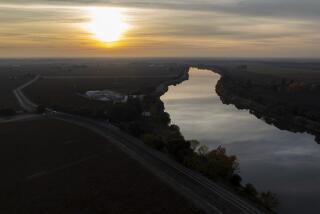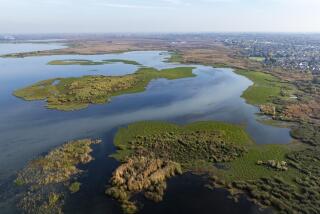Alaska Trailblazers Tunneling Their Way to Tomorrowâs Water Needs
EKLUTNA LAKE, Alaska â Head cocked slightly to avoid a ventilation duct, the engineer gunned his miniature diesel locomotive and the tiny train dove into the tunnel at the base of the Chugach Mountains.
The flat gray light of winter gave way to the pale yellow glow from bulbs strung barely head-high in the narrow corridor.
Then, 6,300 feet from the entrance, the bright white of mercury vapor lights bathed the end of the tunnel. Machinery jamming the space there obscured the equipment eating its way through almost a mile and a half of rock and gravel.
Welcome to the subterranean headquarters of the Eklutna tunnel project.
Not Ideal Vision
Ahead and above is Eklutna Lake. Though nestled in mountain splendor, the seven square miles of gray, silty water is not the ideal vision of a communityâs drinking supply.
But thatâs exactly where Anchorage plans to get enough water to meet its needs well into the 21st Century.
The tunnel will connect with an existing tap, a pipe near the bottom of the lake that provides water to a small hydroelectric plant. After the hookup, the tap will supply both plant and tunnel.
After swirling through the tunnel, the water will cascade six miles to a treatment plant, which will remove the rock powder ground into the water by glaciers.
75% Complete
From there, the water will bubble 22 miles through concrete pipe and enter Anchorageâs water distribution system. The $160-million project is about three-quarters complete.
The big picture was hard to see in the cramped tunnel behind the 40-ton Lovat machine chewing its way through the mountain at about 100 feet a day.
âItâs kinda like being in a submarine,â said Bruce Bray, foreman of one of two crews working 10-hour shifts underground.
With its wooden sides and steel ribs every five feet or so, the tunnel seems more like a whiskey cask turned inside out.
The crew is protected by three-quarter-inch steel tubing that extends 21 feet back from the cutting face of the boring machine. At the tail of the machine, eight hydraulic pistons propel the cutting edges forward with 1.3 million pounds of thrust.
When the tunnel is complete, 24-foot sections of 54-inch concrete pipe will be inserted. Grout will be pumped in to fill the spaces around the pipe.
Rubber joints between the pipe sections will give the pipe some flexibility to deal with the earthquakes commonplace in one of the worldâs most active seismic areas.
Why Worry?
âIf we have a really big (earthquake), itâll break,â Rich Gordon said nonchalantly. Gordon has been building tunnels for 24 years in New Zealand, Ecuador, Panama and Mexico. A career of dealing with forces beyond the comprehension of man has resigned the field engineer not to worry about things he cannot control.
The existing lake tap feeding the hydroelectric project was damaged extensively by the earthquake that devastated south-central Alaska in 1964, Gordon said. That tunnel was repaired, he said, implying that this one could be, too.
Crouched nearly 200 feet beneath the Earthâs surface, the crew had not felt a small earthquake that rattled portions of Anchorage the day before.
Imponderables do not seem to bother the tunnelers in their cramped, grimy quarters. What does upset them are manageable things like a balky hydraulic hose, which had them shut down when a reporter visited.
Two crew members worked to repair the hose that activates heavy guillotine doors just behind the rotary cutting edge. If the tungsten carbide cutters slice into an unexpected pocket of underground water, the doors are designed to slam shut to keep the men and their tunnel from being inundated.
Happened Before
They hit just such a pocket not long ago. Even with the doors operating as designed, silt filled the tunnel several feet deep for several hundred yards. No one was injured, Bray said.
Gordon said he considers the tunnel moderately difficult. It is being bored mostly through silt, clay, gravel and rock that requires very little blasting.
âItâs one of the toughest ones because of the room factor,â said Bray, who spends more time underground than Gordon.
People working around the boring machine and a conveyor belt barely have room to turn around. Even in the finished tunnel, with its 8 1/2-foot diameter, it is impossible to stand straight because everything is curved.
Ventilation ducts, bored from the surface to the tunnel, and a 72,000-volt line to power the $1-million Canadian boring machine eat up valuable space.
To compensate for the crowding, the crew maintains jovial, if cutting, banter.
Someone hummed an Irish folk tune. Gordon said the tunneling trade tends to be dominated by the Irish, many of whom maintain a brogue despite 10 or 20 yearsâ residence in the United States.
Because the trade is almost like a fraternity, tunnelers regularly discover people they have worked with on distant projects.
âYou just keep running into people,â Bray said. His crew members, many of whom live in Alaska, work for a Seattle construction company. But when this job is over, an informal network will keep them posted on tunnel projects elsewhere.
Despite the less than optimal conditions, the men clearly enjoy their work. Gordon said the pay is not bad either. The average tunneler makes about $25 an hour, with another $12 to $13 worth of benefits.
Making Way for Rumble
Finally, repairs were complete. The men squeezed to familiar spots out of the way of the rumbling conveyor belt and powerful jacks.
âWith all the moving parts so close, thereâs always danger,â Bray said. But he does not think it is any more dangerous than underground coal mining.
The cutting face begins its clockwise revolutions, two or three a minute.
A red laser beam streaks through the gloom to keep the boring machine headed in a straight line. The machinery shudders as the blades bite into boulders. A shattered fragment the size of a basketball plops onto the conveyor belt, which carries it back to four or five âmuck carsâ hooked to the mini-locomotive, which will haul the excavations out.
The train runs about every half an hour, none too soon for visitors with even a hint of claustrophobia.
More to Read
Sign up for Essential California
The most important California stories and recommendations in your inbox every morning.
You may occasionally receive promotional content from the Los Angeles Times.










